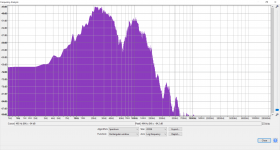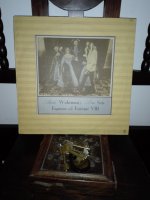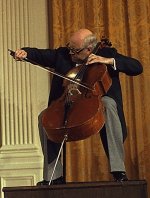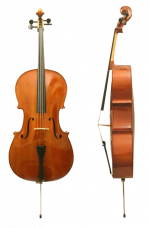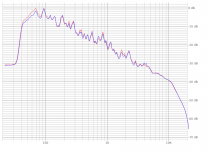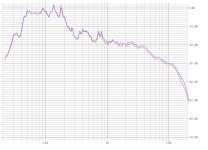The test is simple: Disconnect and connect your subwoofer while listening to music, you will feel the difference, the feeling of realism increases. 😊
When I experience infrasonics, to put into words, I can't hear a tone like say 30hz or 40hz, but there's something there, it's loud but without a direct sound that I can latch onto, it definitely masks other sounds and you can feel vibration (the closer you get to the driver the better). Then when you stop it, suddenly you can hear everything else, it's like a veil is lifted. It's eerie for sure. You can perceive it. It's there.
Very best,
Very best,
Yes, but you need to take maybe 15 dB off the 40 Hz to compare it to stuff in the 80 Hz region, as per ISO 226 (equal loudness). When you do that, the 40 Hz just isn't as audible as the 80 Hz.In terms of acoustic instruments producing actual notes, you're correct.
...
Chris
Very glad you posted the live/recording tape. But I suspect the hole at 77 Hz may be a result of room acoustics just as the 40 Hz just might be boosted.
B.
That shouldn't happen........... Then when you stop it, suddenly you can hear everything else, it's like a veil is lifted. It's eerie for sure. You can perceive it. It's there.
..........
Although there is a crossover frequency chosen generally around 80 Hz, (it will depend on the response of the satellites towards the low zone) the upper zone should not stop being perceived exactly the same, probably the SB is configured with too much gain, which in It actually muddies the bass, but affects the whole.
That shouldn't happen.
Although there is a crossover frequency chosen generally around 80 Hz, (it will depend on the response of the satellites towards the low zone) the upper zone should not stop being perceived exactly the same, probably the SB is configured with too much gain, which in It actually muddies the bass, but affects the whole.
I may have described it oddly; but when I play a 17~18 hz tone for example at say 100db, I don't hear a tone, but I can feel a pressure and other sounds in the house are less audible to me. In a film it's not like this because a tone like that is not held constant really. But just sitting in some infrasonic constant tones is quite eerie feeling.
Very best,
I understand better now what you meant.
infrasonic tones. Well, I don't see why it should form a "veil" over the rest of the music, anyway. But I will tell you that my music system is configured from 20 Hz. Enough to enjoy Bach's Tocatta and Fugue in D Minor without the pictures falling off the walls or grandma's fine souvenir glassware on the floor.
And yes, the arms resting on the chair perceive the vibration and it is a nice sensation, it helps to perceive the illusion of "being there".
I know YT isn't the best for listening to music, but, here goes... 🙂
infrasonic tones. Well, I don't see why it should form a "veil" over the rest of the music, anyway. But I will tell you that my music system is configured from 20 Hz. Enough to enjoy Bach's Tocatta and Fugue in D Minor without the pictures falling off the walls or grandma's fine souvenir glassware on the floor.
And yes, the arms resting on the chair perceive the vibration and it is a nice sensation, it helps to perceive the illusion of "being there".
I know YT isn't the best for listening to music, but, here goes... 🙂
I see the bass drum having twin peaks. 40 Hz and 140 Hz. That would sound like a big thump, right? I don’t see any of the HF that we usually dial in for live sound to give it a crack or snap.
This particular bass drum was pretty well-damped IIRC, with a small duvet shoved in there. There's also the fact that I selected about 10-15s of content for Audacity to analyse, so the short HF impacts probably aren't represented properly.
Yes, but you need to take maybe 15 dB off the 40 Hz to compare it to stuff in the 80 Hz region, as per ISO 226 (equal loudness). When you do that, the 40 Hz just isn't as audible as the 80 Hz.
Very glad you posted the live/recording tape. But I suspect the hole at 77 Hz may be a result of room acoustics just as the 40 Hz just might be boosted.
B.
Ben,
In this case, the mic was positioned at the port of the bass drum, and it's entirely possible that some cancellations were showing up, relating to the dimensions of the drum etc.
I'll see about posting a short sound clip later.
Season's Greetings,
Chris
PS - Bonus spectrum. Different bass drum, different mic. This time it's a Sennheiser e902 which I've modified by taking out the strong EQ contour in the low-mids.
Attachments
Well, I have done the comparison, Tidal offers HI FI quality, my vinyl was played with my best cartridge MC Denon DL103.If I'm to believe Google, only two in that he trumped up charges and had Anne Boleyn and Catherine Howard executed.
Got the vinyl also, but only see a CD, DVD on A&M Records available, though only CD available for sale; regardless looking forward to your comparison as I can't do one anytime soon.
Win the vinyl to my ears, but I do not dare to say that "widely". Sounds more natural?
How to evaluate the tone of a sound radiated by a synthesizer or an electric bass? Also, I must admit that I no longer have the same enthusiasm to listen to musical works that at the time were considered "advanced", revolutionary", etc. I guess I am a "conservative bourgeois" in that regard!
So we agree, there's no bass to impress with its realism in this rock opus. I prefer Rostropovich or Casals playing the cello. 😉
Attachments
Just watched the new Top Gun Maverick film. Here's my RTA graph from the movie:

Plenty of sub bass through the whole film with the jets and engines. Lots of 40hz peak stuff with the explosions, machines, slams, etc. I was getting lots of tactile response from 18~20hz range pretty often with the jet engines in almost every other scene or so, so it was pretty common. And there were a few moments that had spikes down even lower into infrasonics, but it was much more rare, including my spike around 15hz there. That happened maybe once or twice. But the 18~20hz stuff was through the whole movie. And 30hz and up was all the time except in quiet dialog scenes. So this movie absolute needed to have that infrasonic to sub-bass range below 30hz or so much of it would have been missed. The tactile response rumble I was getting at the 18~20hz moments (they were not just peaks, they often sustained a few seconds with a jet engine) made it like you were near the jet feeling all the vibration, it was fun.
Very best,
Plenty of sub bass through the whole film with the jets and engines. Lots of 40hz peak stuff with the explosions, machines, slams, etc. I was getting lots of tactile response from 18~20hz range pretty often with the jet engines in almost every other scene or so, so it was pretty common. And there were a few moments that had spikes down even lower into infrasonics, but it was much more rare, including my spike around 15hz there. That happened maybe once or twice. But the 18~20hz stuff was through the whole movie. And 30hz and up was all the time except in quiet dialog scenes. So this movie absolute needed to have that infrasonic to sub-bass range below 30hz or so much of it would have been missed. The tactile response rumble I was getting at the 18~20hz moments (they were not just peaks, they often sustained a few seconds with a jet engine) made it like you were near the jet feeling all the vibration, it was fun.
Very best,
EdGr, since you claim that "Energy below 40Hz is largely noise", would you like to comment on the spectrum analysis I posted?
That was a bass drum with no EQ or processing - just what the mic picked up.
Chris
That was a bass drum with no EQ or processing - just what the mic picked up.
Chris
I can theorise as to a couple of phenomena. We need to all the way to Descarte: "I think therefore I am." Whilst Chris' data may be accurate it's not particularly relevant. Low frequency sounds are 'experienced' as opposed to 'heard'. A human body and a microphone body have totally different characteristics. I live in my ear-buds. I play mp3s full blast. Yet if I enter my apartment I know if my sound system is on. Despite the music in my ears I feel the house sound system through my feet, in my chest.
A driver may the originator of sub-bass frequencies but what we hear is extremely coloured. Everything in house makes a contribution - press one ear up against a door and stick your finger in the other.
The experience of low frequencies goes some way to explain MalVeaux's concept. Those experienced in computing understand what an 'interrupt' is. As humans we are terrible at multi-tasking. You cannot 'listen' to a band and simultaneously 'watch' - we rapidly switch between the senses. Whilst you were chatting up a pretty blonde the band played their new track - you never noticed. The same way, you were driving home, listening to the game and 10 miles passed without you noticing . . .
MalVeaux's brain is processing 'hearing' and 'feeling' data, by turning the sub off the brain is free to dedicate more resources to the ears.
My $8 worth.
A driver may the originator of sub-bass frequencies but what we hear is extremely coloured. Everything in house makes a contribution - press one ear up against a door and stick your finger in the other.
The experience of low frequencies goes some way to explain MalVeaux's concept. Those experienced in computing understand what an 'interrupt' is. As humans we are terrible at multi-tasking. You cannot 'listen' to a band and simultaneously 'watch' - we rapidly switch between the senses. Whilst you were chatting up a pretty blonde the band played their new track - you never noticed. The same way, you were driving home, listening to the game and 10 miles passed without you noticing . . .
MalVeaux's brain is processing 'hearing' and 'feeling' data, by turning the sub off the brain is free to dedicate more resources to the ears.
My $8 worth.
chris661 - Kudos for measuring a real bass drum. The very low-frequency energy is due to the mallet hitting the drum. It is the initial transient, not perceived as a tone, but gives the impact.
The "Rhiannon" spectrum is among the most bass-heavy that I have seen. Most rock music peaks higher in frequency. This is intentional to avoid spending the limited spectrum on sounds that one can barely hear.
Even worse, nearly all pop/rock music has tipped-up treble to make it "radio-friendly" (Rhiannon is an exception). Every station wants to be the loudest.
I think our observations are consistent - a bass drum can generate very low frequencies, but very little makes its way into the mix.
Ed
The "Rhiannon" spectrum is among the most bass-heavy that I have seen. Most rock music peaks higher in frequency. This is intentional to avoid spending the limited spectrum on sounds that one can barely hear.
Even worse, nearly all pop/rock music has tipped-up treble to make it "radio-friendly" (Rhiannon is an exception). Every station wants to be the loudest.
I think our observations are consistent - a bass drum can generate very low frequencies, but very little makes its way into the mix.
Ed
Yeah, IIRC Tom D. measured ~7 Hz, though his car door slam ~2 Hz was the real eyeopener!a bass drum can generate very low frequencies
Not surprising... that is half a second in the time domain.though his car door slam ~2 Hz was the real eyeopener!
Ed
chris661 - Kudos for measuring a real bass drum. The very low-frequency energy is due to the mallet hitting the drum. It is the initial transient, not perceived as a tone, but gives the impact.
The "Rhiannon" spectrum is among the most bass-heavy that I have seen. Most rock music peaks higher in frequency. This is intentional to avoid spending the limited spectrum on sounds that one can barely hear.
Even worse, nearly all pop/rock music has tipped-up treble to make it "radio-friendly" (Rhiannon is an exception). Every station wants to be the loudest.
I think our observations are consistent - a bass drum can generate very low frequencies, but very little makes its way into the mix.
Ed
Ed,
Thanks.
Just because the impact isn't a "tone", does that mean we shouldn't reproduce it?
The spectrum I posted shows 4Hz is 20dB down on 20Hz. The 4Hz component would require about 2.5x the excursion of the 20Hz component, assuming a speaker mounted in a sealed box. The 20dB down is also ignoring the LF rolloff on the mixing desk input, and the microphone's diminished sensitivity to frequencies that low. It's difficult to determine how much LF signal is lost, since all of my measurement gear also has inherent rolloffs <10Hz, but I'm certain that a DC-coupled microphone & recording device would show much higher levels of the VLF.
FWIW, there's plenty of not-rock-music with stronger intended-by-the-artist <40Hz content. Heck, even the rock bands with a 5-string bass tuned down (low-B = 31Hz) will do the job.
Chris
If I ever had the time, I'd love to run analysis on "avant garde" and "modern composition" electronic music that I'm gravitating towards - it's a bit boring seeing classic rock used as reference when the world of music, and technology to create it, has progressed.
Experiencing Ben Frost's "Widening Gyre" live performance was phenomenal - stacks of subwoofers surrounded the crowd in a large warehouse space, creating a visceral sensation of the sound. I'm sure the speakers themselves would've been the limiting factor in how low the bass could go, and whilst I couldn't expect to recreate that physicality in a home environment I'd still want a system that can do justice to recordings so they can be heard as the artist intended.
Experiencing Ben Frost's "Widening Gyre" live performance was phenomenal - stacks of subwoofers surrounded the crowd in a large warehouse space, creating a visceral sensation of the sound. I'm sure the speakers themselves would've been the limiting factor in how low the bass could go, and whilst I couldn't expect to recreate that physicality in a home environment I'd still want a system that can do justice to recordings so they can be heard as the artist intended.
Chris - Here is the spectrum of a somewhat more recent rock recording - Metallica's "Enter Sandman".
This one also rolls off very quickly below 40Hz. "Enter Sandman" has a lot of high-frequency energy (enough to drive listeners from the room if played loudly). 😉
I am not saying that low bass should be rolled-off, just that it has been in all of pop/rock recordings that I have analyzed.
Ed
This one also rolls off very quickly below 40Hz. "Enter Sandman" has a lot of high-frequency energy (enough to drive listeners from the room if played loudly). 😉
I am not saying that low bass should be rolled-off, just that it has been in all of pop/rock recordings that I have analyzed.
Ed
Attachments
Part of my hobby is running FFTs
Hello EdGr,
Do you run any FFT analysis using matlab scripts on matlab software itself or using Octave?
Enter Sandman was released in 1991 - Metallica tune to E and use 4 string bass, far removed from the Drop B tuning and 5 string bass (or 8 string guitars!) of modern heavy music.
- Home
- Loudspeakers
- Subwoofers
- 10-25 Hz, is it necessary for HT or Music?
